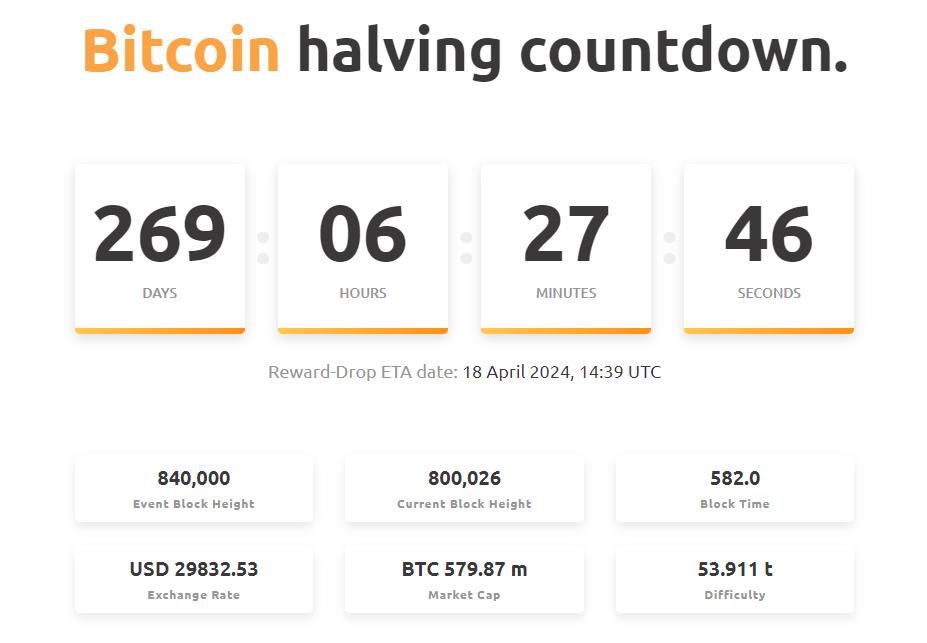
The Bitcoin network has mined block 800,000, with just 40,000 left to mine before the network’s next mining reward halving.
The 800,000th block contained 3721 transactions at 1.64 megabytes, with the price of Bitcoin (BTC) trading at $29,815 on July 24, as market researcher Dylan LeClair noted on Twitter:
#Bitcoin block 800,000. pic.twitter.com/Yw9c6klqbY
— Dylan LeClair (@DylanLeClair_) July 24, 2023
The milestone was widely shared across the social media platform on July 24, with Bitcoin proponents and industry commentators highlighting the milestone as an indicator of network security and resilience:
The #Bitcoin network just produced block number 800,000.
— Walker⚡️ (@WalkerAmerica) July 24, 2023
800,000 blocks without a central bank.
800,000 blocks without a government.
800,000 blocks without a CEO.
800,000 blocks without asking for permission. pic.twitter.com/hf8RpC3jlP
Bitcoin’s block height refers to the location on the blockchain relative to how many blocks preceded it — back to the genesis block, which was the founding block of the network. Blocks contain transactions and data bundled into blocks by network miners.
₿: 800,000th bitcoin block mined! pic.twitter.com/uGKi15zRaO
— Documenting ₿itcoin (@DocumentingBTC) July 24, 2023
The metric acts as a chronological order of transactions and blocks of the network, with each new block connected to the previous one in the chain. This allows users to identify the order in which transactions are recorded.
Block height also serves as a measure of the Bitcoin blockchain’s immutability. The more blocks added to the chain, the more computing power is required for a malicious actor to attempt to tamper with previous blocks.
Related: Bitcoin miners still bullish despite toughest bear market yet — Hut8, Foundry, Braiins
As previously explained by Cointelegraph, a 50% attack would require an attacker to gain enough computing power to monopolize generating new blocks and receive rewards since they’re able to prevent other miners from completing blocks. The attacker could also reverse transactions.
Block height also serves as a measure used to maintain Bitcoin’s mining difficulty. Proof-of-work-based blockchain networks have their mining difficulty adjusted periodically based on the total computational power of the network and the time it took to mine a certain number of previous blocks.
The Bitcoin network generates a new block roughly every 10 minutes. If more hashing power is added to the network, it impacts this metric and automatically adjusts the mining difficulty every two weeks to maintain equilibrium.
Block height also dictates the amount of Bitcoin rewarded to miners for adding a new block to the network. Bitcoin is designed to have a block-halving event every four years or 210,000 blocks on the chain.

The initial block reward was 50 BTC back in 2009, before it subsequently halved to 25 BTC, 12.5 BTC and currently 6.25 BTC in 2012, 2016 and 2020.
Bitcoin’s next halving is earmarked to take place in April 2024, with the latest block reward halving to 3.125 BTC. Halving events historically coincide with major price rallies for BTC and the wider cryptocurrency markets.
With less than a year to the next halving, other macro events have also arrested Bitcoin’s price decline following its last major peak at $69,000. Analysts and commentators have speculated that the latest Bitcoin exchange-traded funds (ETFs) filings from the likes of global asset managers BlackRock and Fidelity indicate renewed institutional interest in Bitcoin.
Magazine: Bitcoin 2023 in Miami comes to grips with ‘shitcoins on Bitcoin’
Title: Bitcoin block 800,000 mined — What’s next?
Sourced From: cointelegraph.com/news/bitcoin-800000-block-mined
Published Date: Mon, 24 Jul 2023 09:50:00 +0100
Did you miss our previous article...
https://trendinginthenews.com/crypto-currency/worldcoin-launches-token-to-distinguish-humans-from-bots






